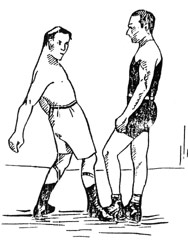
https://www.youtube.com/watch?v=UvLN0JlX8BI
Rapa outwardly looks like a simple footsweep applied against the outside of opponent's foot(done sometimes even today). But that is not true; such sweep would only hurt both parties, taking somebody down only by accident.

(Rapa in Burlamaqui, 1928)
True Rapa is a banda; it is applied against a firm stance, and sweeps both feet. But to do that, it must be done properly.
You must use Rooster+Seduction1 mechanics.
Using this mechanics, sweep with the inside of your right foot against the side of opponent's left foot. This movement is a high-energy point; shout "Ho!" as you sweep.
The moment you sweep againt the outer side of opponent's foot, it applies a nerve disruption that makes him shift his weight onto his heels - which allows them to be swept away.
This is the key to rapa. Without this disruptor, the sweep relies on brute force and is usually unsuccessful.
Sweep both opponent's heels to the left, making him spin and fall on his back or side.
-
Rapa somewhat resembles a (standing) Rasteira; however, it is a different type of technique tactically. While Rasteira is a guardbreaker, Rapa is a banda, as it is too clumsy to be a guardbreaker.
-
If you use Rapa in a fight, as with any banda, immediately stomp on opponent's head (or fall on him with your elbow).
-
'Rapa' means a teetotum(small spinning top); which probably refers to the way the opponent spins around his heels as he is taken down by the technique.
-
Note: Originally, I wrote here that Rapas can be done continually from side to side. That is impossible; instead, for consecutive Rapas, you use the same leg and rotate it under your body in the style of Corta capim. For details, see the Second book.
-
As noted, outwardly similar sweep to the outside of the foot is sometimes done even today; however, this only works if the opponent is just stepping on the foot, shifting his weight onto it. This is not Rapa; Rapa is the banda described above and is done with opponent's full weight on both feet.
-
It is interesting to compare Rapa with similar judo throws. In judo, the opponent is first unbalanced by the use of hands pulling his gi; once in this unbalanced position, his legs are swept from under him using your leg. However, with Rapa, the leg action must do both things: First, it unbalances the opponent (using nerve disruptor); then it throws him.
The unbalancing action in Rapa is higher level than in judo, because it works by affecting opponent's nerve system.
This Web Page was Built with PageBreeze Free HTML Editor